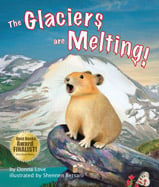Alignment to Standards for SD

| Grade | Number | Standard |
|---|---|---|
| 1 | SC-1.L.3.1. | Students are able to relate characteristics of plants and animals that allow them to live in specific habitats. |
| 2 | SC-2.E.1.2. | geological features using maps and globes. e.g. Locate mountains, plains, valleys, and bodies of water on a globe or map. |
| 2 | SC-2.E.1.2.a | Recognize most of the Earthês surface is covered with water. |
| 2 | SC-2.E.1.3. | recognize and distinguish between forms of water in the Earth system: snow, ice, fresh water, salt water |
| 2 | SC-2.L.1.2. | classify people and animals according to similarities and differences: Classify animals by color, size, shape, body parts, gender, and offspring.Carnivore/herbirvore? |
| 2 | SC-2.L.3.1. | Students are able to describe ways that plants and animals depend on each other. (seed dispersal, nest, plants in food webs) |
| 2 | SC-2.L.3.2. | associate adaptations in plants and animals in response to seasonal changes. Animals that migrate, hibernate, use camouflage, or go dormant. |
| 2 | SS-2.G.1.2. | Use simple map reading skills to identify the map title, label four directions on a compass rose, and interpret the symbols of a map key/legend. |
| 3 | SC-3.E.1.2. | Describe how humans use Earthês natural resources, e.g. minerals for jewelry or trees for paper |
| 3 | SC-3.L.1.1/2.a | Differentiate between plants and animals. |
| 3 | SC-3.L.1.2. | identify characteristic features of animals and their related functions in relation to their environment: wings/ hollow bones, webbed feet, fins |
| 3 | SC-3.L.2.1. | animals instinctively meet basic needs in their environment: baby birds know to open their mouths for food; newborn turtles know to go to water, birds know how to build nests, |
| 3 | SC-3.L.3.1. | species depend on one another and on the environment for survival. |
| 3 | SC-3.L.3.2. | environments support a diversity of plants and animals. |
| 3 | SC-3.L.3.2.a | types of environments, e.g. deserts and what lives there |
| 3 | SC-3.L.3.3. | ways humans impact air, water, and habitat quality. (pollution) |
| 3 | SC-3.S.2.0. | Investigate how natural events and human influences can affect the survival of species. |
| 3 | SS-3.G.1.1. | Identify and use map components. |
| 3 | SS-3.G.1.3. | Locate the seven continents, four major oceans, major United States landforms, and state boundaries on a map or globe. |
| 4 | SC-4.L.2.1. | behavioral and structural adaptations that allow a plant or animal to survive in a particular environment. |
| 4 | SC-4.L.2.2. | a size of a population is dependent upon the available resources within its community. |
| 5 | SC-5.E.1.1.b | Earthês surface is constantly changing: earthquakes, volcanoes, weathering, erosion, and deposition |
| 5 | SC-5.L.3.1. | natural events and/or human influences may help or harm ecosystems: biotic (over-population) and abiotic (floods) |
| 5 | SC-5.L.3.2. | the transfer of energy using an energy pyramid model: producer, consumer, decomposer, herbivore, carnivore, omnivore, predator _ prey |
| K | SC-K.E.1.1.a | Explore rocks, sand, water, and soil. |
| K | SC-K.L.1.1.b | Students are able to compare size and shape of living things. E.g. gather and sort a variety of leaves, order a variety of mammals from smallest to largest. |
| K | SC-K.P.1.2. | Students are able to identify water in its solid and liquid forms. |
| K | SC-K.P.1.2.a | Observe ice in the environment. |
| K | SC-K.P.1.2.b | Observe water in the environment. |
| K | SC-K.P.1.2.c | Students are able to observe physical changes in matter. |
| K | SC-K.P.2.1. | Students are able identify things that move. |